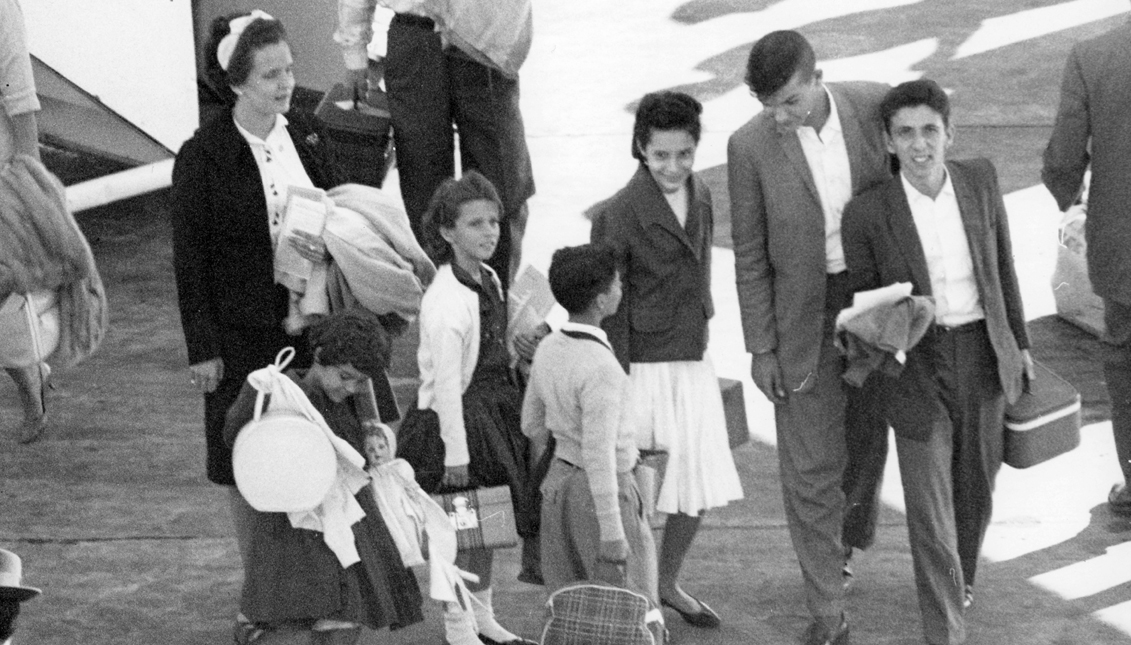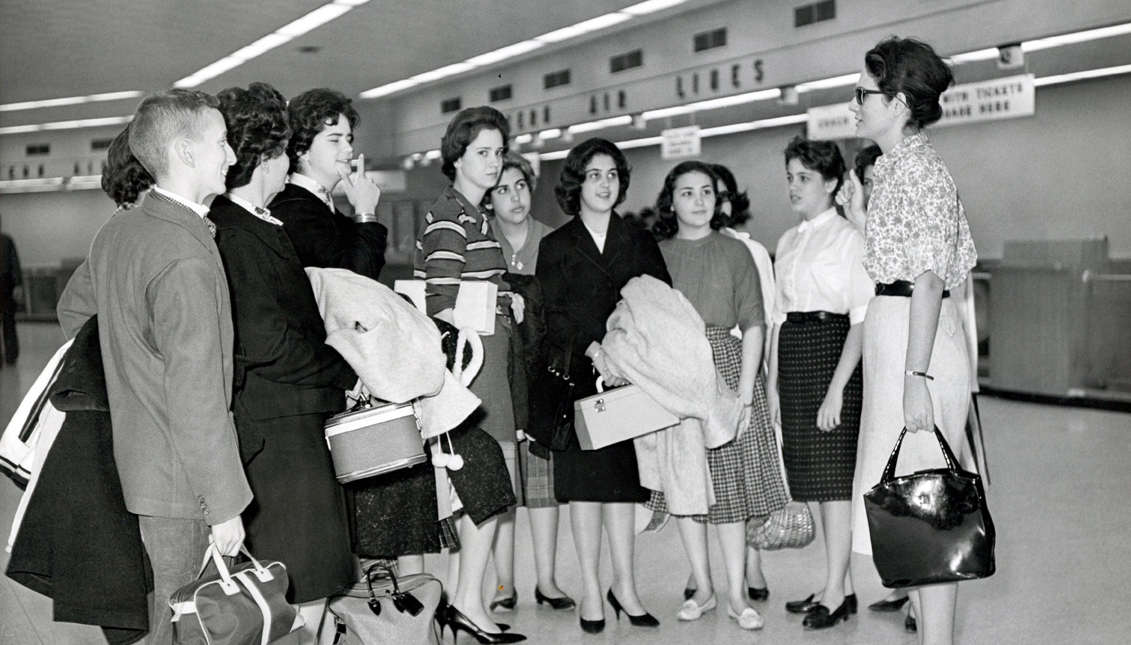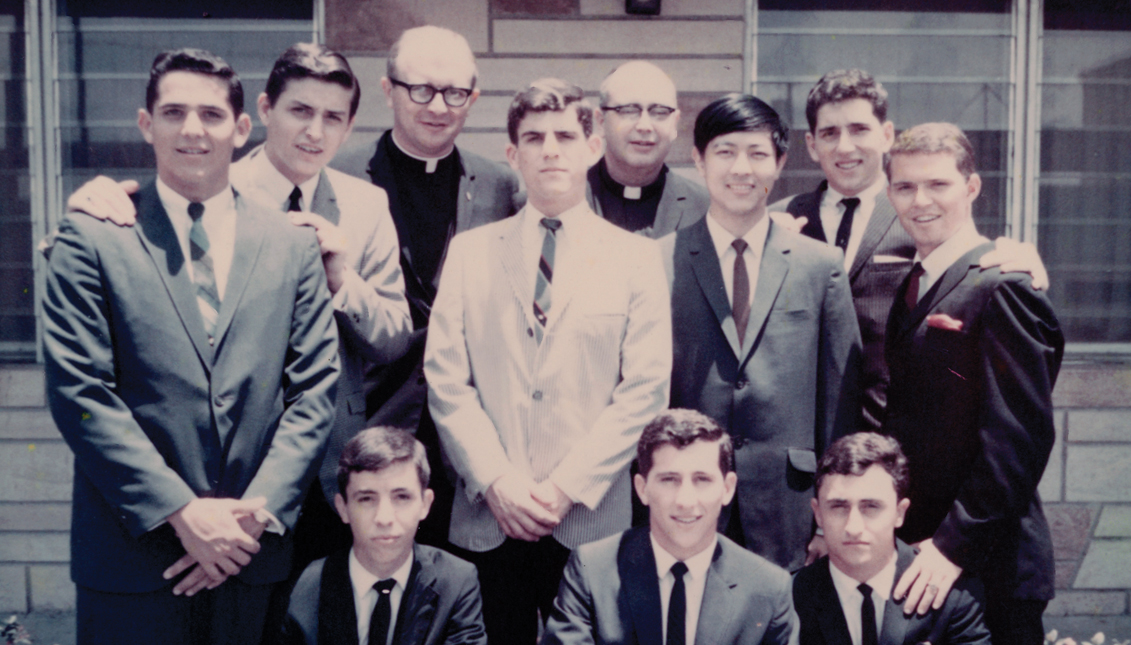
Bonded in Exile, 60 Years After Operation 'Pedro Pan'
More than 14,000 Cuban children were brought to the U.S. undercover between 1960 and 1961.
Professor Marcos Kerbel will always remember when his mother woke him up in the middle of the night to tell him that the dictator Fulgencio Batista had left Cuba. It was the night of January 31 into January 1, 1959, and Marcos was about 14 years old when he witnessed the wave of sheer joy that flooded the streets of the island with the promise of a new beginning after seven years of harsh military repression.
This is what he tells the History Miami Museum in a documentary that compiles the testimonies of so many young people who boarded a plane without knowing when they would see their native island again.
Shortly after the start of the Revolution dreamed of by Fidel Castro and El Che, many Cuban families began to fear that this promise was a threat, especially those who belonged to a wealthy class and had much to lose.
Thus began the largest child exodus of the twentieth century in Latin America. More than 14,000 Cuban children traveled to the United States without their parents, fleeing from“Castro's hecatomb”, as described by writer and feminist Ileana Fuentes last December on the occasion of the celebration of the 60th anniversary of Operation ‘Pedro Pan.’
“There were the Committees for the Defense of the Revolution. One of them was in the corner of my house,” Francisco Angones, the first Cuban director of the Florida Bar told Al DIA. “And these people I knew since I was a kid started turning their backs on us and we had to be careful with what we said, even at home.”
“There were the Committees for the Defense of the Revolution. One of them was in the corner of my house,” Francisco Angones, the first Cuban director of the Florida Bar told Al DIA. “And these people I knew since I was a kid started turning their backs on us and we had to be careful with what we said, even at home.”
Angones' father feared that they were being watched. Soon after, many Cubans became "enemies" of the Revolution because they did not want their businesses to be expropriated — one of the first ordinances imposed by the new regime — or because they disagreed with the new political ideas, were Catholics, or feared that their children would become "children of the Revolution.”
“Castro decided to close all Catholic schools and private schools, and all religious people were expelled from Cuba in a boat called Covadonga, in 61”, Cuban businessman Antonio Argiz added.

Argiz, like Republican Senator Mel Martinez, Professor Kerbel or Attorney Angones have something in common: they are successful people in the United States and are part of the so-called “Pedro Pan (Peter Pan) Generation,” made up of more than 14,000 Cuban boys and girls, part of one of the largest child exoduses in the Western hemisphere.
It is one of the least known covert operations of the Cold War, and still subject of controversy today because although families sent their children clandestinely to the United States to escape repression — initially those whose parents lived under threat — there is still speculation about the involvement of the CIA in the mass exodus.
Not all the children encountered the same fate: approximately 8,000 were sent to hospices because they had no legal guardian in the United States.
The exodus began on December 26 with the first batch of children who said goodbye to their parents behind the fish tank at Havana's José Martí Airport — many of them still very young — thinking that they were going to spend a few weeks away from home, at least until the revolutionary regime “fell,” their parents said.
The idea behind saving children from "communism" had a religious leader, Father Bryan Walsh, director of a Catholic charity in Miami, who in 1960 took in a Cuban boy named Pedro who had crossed the pond alone.
Walsh began to fear that the children of Castro's “enemies” would suffer more and more repression. At that time, rumors began to spread that these children would be sent to satellite countries of the USSR and that their parents would lose custody, something that Castro always denied and maintained was CIA speculation..
It was then that Walsh contacted the Eisenhower administration asking for their help in providing visa waivers for refugee children arriving in the United States. He also asked for funding for the Catholic organization that took them in and received other private donations from Cuban companies and people in exile.
He also had another expert collaborator, British nurse Penny Powers, who had helped Jewish children escape from Germany during the war, and Ramon and Polita Grau, both later imprisoned.
The American press was silent about the operation. Father Walsh's intention was that the children should not be used as political propaganda.
On the first flight, which took off from José Martí Airport on December 26, 1960, only two Cuban children were traveling. Two days later, there were two more. Six on the 30th and twelve on the 31st.
In an unprecedented move by the US - a country that had never paid for a program for refugee children - thousands of children managed to escape Cuba.

The little ones arrived confused, in a new country, not understanding a word of a new language and facing a culture that was not their own, far from their parents, and not knowing when they would see them again.
They were taken to camps in Miami such as Matecumbe and the barracks in Kendall, as writer Ileana Fuentes, a Pan child, explained to Al Dia. There they would spend what could be months until they were relocated either to a relative's home, a foster home, or, if they were unlucky or unclaimed by anyone, to an orphanage sponsored by the Cuban Children's Program.
In the first few months, some families did manage to arrange their visas and be reunited with their children in the United States, while others took several years. Like writer and Yale professor Carlos Eire, who won the 2003 National Book Award for his memoir Waiting for Snow in Havana, where he remembers his time in a foster home, surrounded by other kids who urged him to join gangs. Eire didn’t have had a guardian — a mistake in the system caused his uncle's claim, exiled to the US, to be lost in the midst of bureaucracy.
RELATED CONTENT
Nevertheless, both he and his brother hoped that their mother would join them. And they dreamed it very much. Until disaster struck.
The Cuban missile crisis broke out in November 1962; Cuba and the United States were at the brink of a nuclear war, and flights between both countries were canceled a month earlier, in October.
That meant the end of Operation ‘Pedro Pan,’ with the last flight taking off on October 23, 1962. And although Eire's family was later able to reunite, there are those, like the lawyer Emilio Cueto, who spent almost twenty years without seeing their family and had to jump through real bureaucratic hoops to get back to Cuba.

Juan Pujol, who fled the province of Matanzas at the age of 15 and whose family was dedicated to preaching the Catholic faith, was only able to return to Havana 17 years later.
“I would not have wanted to leave Cuba, but the circumstances... The revolutionary government that took effect on January 1, 1959, began to make drastic changes. A lot of shooting, a lot of killing was seen in the newspapers,” he told AL DÍA.
Fearful of being shot, Juan's parents contacted some friends who had taken a son to the United States, and on August 9, 1962, the young Cuban arrived in Miami, at the Matecumbe camp, where some 500 teenage boys lived.
“After that, they sent me to a place that was like a motel that became a camp, but they closed it down and I went to Opa Locka, which had been an airbase, and they fitted it out,” he explained.
“After that, they sent me to a place that was like a motel that became a camp, but they closed it down and I went to Opa Locka, which had been an airbase, and they fitted it out,” he explained.
When the missile crisis broke out, he already knew that he would not be able to see his family. “I was the only one of my family who was here and I knew that none of them would come. That night I went into the field and cried a lot. I cried and prayed,” he concluded.
At 19, Pujol had to face the streets and began working as a locksmith, later joining the army and marrying another girl from the ‘Pedro Pan’ cohort.
The connection between this generation of migrants, which some define as the "vanguard of the exile,” is strong and has continued over the years thanks to the efforts of organizations such as the Pedro Pan Foundation, which ensures that their testimony is not lost.
And in fact, it is more than enduring, whether we like it or not. he controversy over the little rafter boy Elián, who arrived in Miami only after seeing his mother die at sea, and was claimed by relatives and made the object of a dispute between the United States and Cuba, dangerously reminded us of the echoes of that earlier trauma.
Just like the thousands of Central American children detained at the border and locked up in cages far from their parents, only they are no longer the chess pieces in a struggle between systems, but side effects of one of them.
Today, 60 years after the mythical Operation ‘Pedro Pan,’ the wounds are still open, and its protagonists show them in exhibitions such as the one that will open this January in the American Museum of the Cuban Diaspora.
We shall not forget that Pan's children are not the only ones twinned in the exodus. Every earthquake has its aftershocks, sometimes miles away from the first eruption. History always reaches out to teach us.











LEAVE A COMMENT: